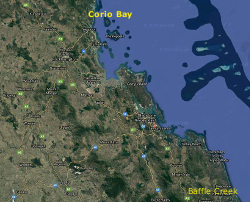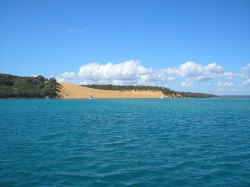|
|
Shorebirds Corio Bay to Baffle CreekThe coastline from the Corio Bay Ramsar site south to Baffle Creek, contains several significant areas of shorebird habitat. In addition to the mainland, shorebird populations can be found on the offshore islands and cays. The islands are important for rarer coastal species not usually found on the mainland coast, such as the wandering tattler. Over 14,000 shorebirds occur within the Curtis Coast. Queensland shorebird species - Bird wetland indicator species and profiles A number of studies have focused on the Curtis Coast region. In the 1990’s there were regular voluntary shorebird surveys conducted through the Port Curtis Wader Study Group. More roost sites in the area are now known, especially those close to Gladstone, on Curtis Island and in the Fitzroy River delta. There are some information gaps, however a considerable amount of work has been commissioned by the Gladstone Ports Corporation. The coastline from Corio Bay to Port Alma has small enclaves of shorebirds, some of which have been regularly monitored e.g. Kinka Beach. The stretch of coastline between Keppel Sands and the mouth of the Fitzroy River is known to host significant numbers of great knot. The coastline varies from mud banks to mangrove islands and channels at the mouth of the Fitzroy River south to the sandy coastlines of Seventeen Seventy. The area includes the Narrows and Curtis Island. Facing Island forms the eastern boundary of Port Curtis. The tidal flats between Curtis and Facing Island are important feeding areas for shorebirds. To the south there are a series of interconnected estuaries which have been identified as important shorebird habitat, in particular Seven Mile Creek to Rodds Harbour area and Pancake Creek. The estuaries contain fine mud sediments. However, there are abundant sandy sediments at Pancake Creek (Bustard Head), Round Hill Creek (Seventeen Seventy) and Yellow Patch Inlet on Curtis Island. Yellow Patch Inlet is the most important shorebird site along this section of coastline. The Fitzroy River Delta and nearby northern end of Curtis Island are also significant shorebird sites. The number of eastern curlew and whimbrel using the many channels in the area is also noteworthy. The significance of Corio Bay for shorebirds is recognised by its inclusion in the Flyway Site Network and as a Ramsar site AcknowledgementsThis information has been compiled by the Queensland Wader Study Group with input from the Queensland Parks and Wildlife Service, researchers and volunteers (from Australasian Wader Study Group, Birds Queensland, the Port Curtis Wader Study Group, the Wildlife Preservation Society of Queensland, Birds Australia and the Mackay Conservation Group). These pages are primarily sourced from the report prepared by the Queensland Ornithological Society Inc for the Queensland Department of Environment and Heritage Protection and the Australian Heritage Committee, Driscoll, P. V. 1995. Survey of wader and waterbird communities along the central Queensland coast. Please note the information above is based on the best available at the time of publication. Last updated: 2 February 2021 This page should be cited as: Department of Environment, Science and Innovation, Queensland (2021) Shorebirds Corio Bay to Baffle Creek, WetlandInfo website, accessed 8 May 2025. Available at: https://wetlandinfo.des.qld.gov.au/wetlands/ecology/components/biota/fauna/fauna-taxon/birds/shore-bird/migratory-qld/corio-baffle.html |

 — Department of the Environment, Tourism, Science and Innovation
— Department of the Environment, Tourism, Science and Innovation



